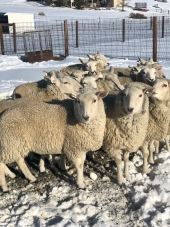One Polish veterinary student is running a great Fb page about small ruminants, and once she described an issue with a bottle fed lamb:
"The lamb that's "drinking with rumen" - the story of Beltex's fall.
A case from this year's 🍀 spring lambing- a lamb that hadn't shown any signs of disturbing symptoms before was found dead in the morning. Why? 🕵♂
I did an autopsy and it turned out that the probable cause was the obstruction of the ostium reticuloomasicum, such as the woolen trichobezoars ❌ A few small wool bundles located in this strategic place were enough to effectively disrupt the motoric function of the gastrointestinal tract.... 😔The consequence of this is an acidic indigestion, disorders of pre-stomach function and digestive processes.
OSTIUM RETICULOOMASICUM
🎯(marked with a red circle) is a narrow element ending the reticular groove [silcus reticuli], which exists both in lambs 🐑and goatlings 🐐The structure of these musculars folds, influenced by the sucking reflex, tight and form a tube that leads the milk directly to the maw [abomasum], the final stomach. There, the milk is properly digested and casein is cut under the influence of hydrochloric acid and rennet.
So-called "Drinking with rumen":
If the reticular groove doesn't function properly, milk (or milk replacer) doesn't reach the final stomach [abomasum], but the reticulorumen space and the result of bacterial fermentation in the developing stomach so quickly leads to severe and acute digestive disorders (acidic indigestion).
HOW DOES IT WORK? 🤔
Fermentation of sugars causes mass production of volatile fatty acids (VFA) and increase of lactic acid (LA) level, which leads to decrease of pH and disorders of microflora 🦠
❗CAUTION❗
Due to the specific nature of the physiology of lambs and goatlings digestive system,
it is so important to hold the bottle properly during feeding! 🍼
The bottle should be placed slightly above the head of the animal and at an angle to force the neck out, and thus the natural closing of the reticular groove."
Here is her post:
https://www.facebook.com/anibeeeanimeee/posts/150168776379506
Also check out the rest of her page, very thorough and informative.
Although, it can be something else... maybe the lamb is just stressed?








